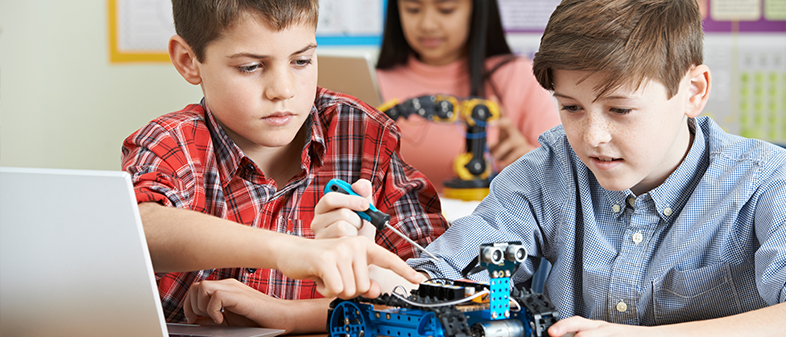
Makerspaces are emerging as a way to encourage student creativity, imagination and group communication in schools.
Makerspaces can be as unique as the students that use them, and there is no one right way to create one. However, a makerspace can be loosely defined as a collaborative lab or studio space where students create, think, share and grow using an assortment of materials and technologies.
Even the name "makerspace" varies: fab lab, TechShop, hackerspace or hacklab are all terms used by practitioners to describe the environment.
These spaces can have high-tech "maker equipment" such as 3D printers, laser cutters and coding kits or simple, no-tech tools such as Legos, Playdoh and cardboard. They are often developed in libraries, formerly underutilized spaces and even classrooms.
Some 21st century education leaders believe these modern makerspaces can provide the hands-on learning skills that will better prepare students for the jobs of today and tomorrow.
In fact, a recent Committee for Economic Development report found "teamwork, problem solving, and ability to work with others of diverse backgrounds" are the top three skills sought by U.S. businesses.
So where do makerspaces fit in
Here are just some of the ways makerspaces can boost student learning and develop 21st century skills.
Researchers have found:
- Students who "participated in activities involving innovation were inquisitive, imaginative and motivated. They wanted to solve real problems that could help people."
- "(C)reativity, design, and engineering are making their way to the forefront of educational considerations, as tools such as robotics, 3D printers, and web-based 3D modeling applications become accessible to more people. Makerspaces are increasingly being looked to as a method for engaging learners in creative, higher-order problem-solving through hands-on design, construction, and iteration."
- High-school-age users of YOUmedia (makerspace) at the Chicago Public Library described these effects of the space: Feeling of safety, community, and belonging; greater involvement with chosen interests; improvement in at least one digital media skill; improved academic, communication and writing skills and better understanding of opportunities after high school.
- Makerspaces "turn every student into a creator, allowing them to make connections between science, language, math, music, and art. Although often taught as separate functions, each subject builds off knowledge from the others to create a full picture.
- The Maker Education Initiative showed "about half the surveyed representatives of maker spaces reported alignment with Next Generation Science Standards, and about 40 percent reported alignment with the common standards. What's more, about 50 percent reported fostering skills such as problem identification, effective communication of ideas, and evaluation and refinement of creative ideas."
Davis, Michelle. "Makerspaces: the benefits." CuriosityCommons of Libraries and Learning. 2015. Web: https://curiositycommons.wordpress.com/makerspaces-the-benefits/
Hartnett, Elizabeth J. "Why Make? An exploration of User-Perceived Benefits of Makerspaces. Nov. 28, 2016. Public Libraries Online. Web.
http://publiclibrariesonline.org/2016/11/why-make-an-exploration-of-user-perceived-benefits-of-makerspaces/
Pereira, Jahnell. "Making a Makerspace: Planning and Building a Successful Makerspace." Sparkfun Electronics. Web.
http://cdn2.hubspot.net/hubfs/2224003/EDU/Newsletter/November/MakerSpace%20whitepaper.pdf
Bell, Jacob. "School Librarians Push for More Maker Spaces." Education Week. April 26, 2017. Web.
http://www.edweek.org/ew/articles/2015/05/13/school-librarians-push-for-more-maker-spaces.html


